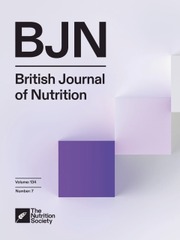Crossref Citations
This article has been cited by the following publications. This list is generated based on data provided by
Crossref.
Selvaraj, Ramesh Kumar
and
Cherian, Gita
2004.
Dietary n‐3 fatty acids reduce the delayed hypersensitivity reaction and antibody production more than n‐6 fatty acids in broiler birds.
European Journal of Lipid Science and Technology,
Vol. 106,
Issue. 1,
p.
3.
Nichenametla, Sailendra N.
South, Elizabeth H.
and
Exon, Jerry H.
2004.
Interaction of Conjugated Linoleic Acid, Sphingomyelin, and Butyrate on Formation of Colonic Aberrant Crypt Foci and Immune Functions in Rats.
Journal of Toxicology and Environmental Health, Part A,
Vol. 67,
Issue. 6,
p.
469.
Lai, Changhua
Yin, Jingdong
Li, Defa
Zhao, Lidan
and
Chen, Xingjie
2005.
Effects of dietary conjugated linoleic acid supplementation on performance and immune function of weaned pigs.
Archives of Animal Nutrition,
Vol. 59,
Issue. 1,
p.
41.
Zhang, Haijun
Guo, Yuming
and
Yuan, Jianmin
2005.
Effects of conjugated linoleic acids on growth performance, serum lysozyme activity, lymphocyte proliferation,and antibody production in broiler chicks.
Archives of Animal Nutrition,
Vol. 59,
Issue. 5,
p.
293.
Zhang, Haijun
Guo, Yuming
and
Yuan, Jianmin
2005.
Conjugated linoleic acid enhanced the immune function in broiler chicks.
British Journal of Nutrition,
Vol. 94,
Issue. 5,
p.
746.
He, Xi
Zhang, Haijun
Yang, Xiaojun
Zhang, Shirui
Dai, Qiuzhong
Xiao, Wenjun
and
Ren, Guopu
2007.
Modulation of immune function by conjugated linoleic acid in chickens.
Food and Agricultural Immunology,
Vol. 18,
Issue. 3-4,
p.
169.
Klasing, K.C.
2007.
Nutrition and the immune system.
British Poultry Science,
Vol. 48,
Issue. 5,
p.
525.
Kim, So-Young
Kim, Sung-Hee
and
Kim, Gyeong-Eup
2007.
Effects of Conjugated Double Bond Derivatives of Polyunsaturated Fatty Acid on Serum Lipids in Rats.
Journal of the Korean Society of Food Science and Nutrition,
Vol. 36,
Issue. 9,
p.
1120.
Park, Cherl-Woo
Bahn, Kyeong-Nyeo
Lee, Young-Nam
Kim, Jeong-Ok
Kim, Min-Seok
and
Ha, Yeong-Lae
2007.
Conjugated Linoleic Acid in Korean Mothers' Milk and Infant Formula.
Journal of the Korean Society of Food Science and Nutrition,
Vol. 36,
Issue. 3,
p.
371.
Babu, Uma S
and
Raybourne, Richard B
2008.
Impact of dietary components on chicken immune system andSalmonellainfection.
Expert Review of Anti-infective Therapy,
Vol. 6,
Issue. 1,
p.
121.
KOUTSOS, ELIZABETH A.
and
KLASING, KIRK C.
2008.
Avian Immunology.
p.
323.
Khatibjoo, A.
Kermanshahi, H.
Golian, A.
and
Zaghari, M.
2011.
The effect of dietary n-6:n-3 ratio and sex on broiler breeder immunity.
Poultry Science,
Vol. 90,
Issue. 10,
p.
2209.
الكريم, فؤاد سالم
2011.
أحماض اللينوليك المقترنة : تخليقها في جسم الحيوان المجتر وتأثيرها على صحة المستهلك.
Al-Mukhtar Journal of Sciences,
Vol. 26,
Issue. 1,
p.
158.
Koutsos, Elizabeth A.
and
Klasing, Kirk C.
2014.
Avian Immunology.
p.
299.
Azadegan mehr, Mona
Hassanabadi, Ahmad
Mirghelenj, Seyed Ali
and
Kermanshahi, Hassan
2014.
Effects of in ovo injection of conjugated linoleic acid on immune status and blood biochemical factors of broiler chickens.
Spanish Journal of Agricultural Research,
Vol. 12,
Issue. 2,
p.
455.
Liu, Xuelan
Zhang, Yan
Yan, Peipei
Shi, Tianhong
and
Wei, Xiangfa
2016.
Effects of conjugated linoleic acid on the performance of laying hens, lipid composition of egg yolk, egg flavor, and serum components.
Asian-Australasian Journal of Animal Sciences,
Vol. 30,
Issue. 3,
p.
417.
Liu, Yong Xiang
Yang, Jian Ping
Tang, Guo Pan
and
Jiang, Dong Feng
2017.
Effects of dietary conjugated linoleic acid on the intestinal mucosal immunity of broiler chickens.
Italian Journal of Animal Science,
Vol. 16,
Issue. 4,
p.
601.
Zhang, P. F.
Shi, B. L.
Su, J. L.
Yue, Y. X.
Cao, Z. X.
Chu, W. B.
Li, K.
and
Yan, S. M.
2017.
Relieving effect of Artemisia argyi aqueous extract on immune stress in broilers.
Journal of Animal Physiology and Animal Nutrition,
Vol. 101,
Issue. 2,
p.
251.
Li, Kun
Zhang, Pengfei
Shi, Binlin
Su, Junling
Yue, Yuanxi
Tong, Manman
and
Yan, Sumei
2017.
DietaryArtemisia ordosicaextract alleviating immune stress in broilers exposed to lipopolysaccharide.
Italian Journal of Animal Science,
Vol. 16,
Issue. 2,
p.
301.
Shokryazdan, Parisa
Rajion, Mohamed Ali
Meng, Goh Yong
Boo, Liang Juan
Ebrahimi, Mahdi
Royan, Maryam
Sahebi, Mahbod
Azizi, Parisa
Abiri, Rambod
and
Jahromi, Mohammad Faseleh
2017.
Conjugated linoleic acid: A potent fatty acid linked to animal and human health.
Critical Reviews in Food Science and Nutrition,
Vol. 57,
Issue. 13,
p.
2737.




